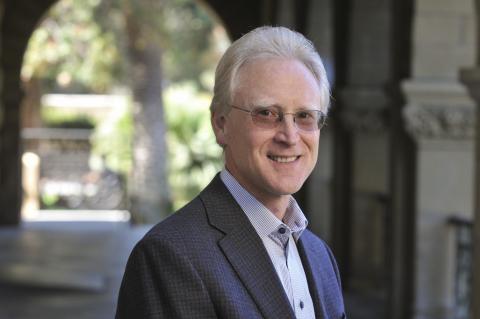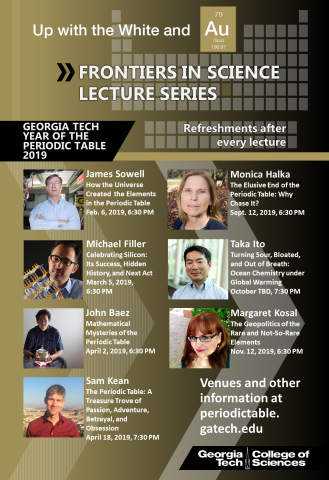event
Plutonium Chemistry and the Battlefields of the Cold War
Primary tabs
A Frontiers in Science Lecture to celebrate 2019, the International Year of the Periodic Table
The Cold War rivalry between the United States and the Soviet Union lasted for much of the second half of the 20th century. While the superpowers never engaged directly in full-scale armed combat, a nuclear arms race became the centerpiece of a doctrine of mutually assured destruction, and prompted a mass production of plutonium, and the designing, building, and testing of large numbers of nuclear weapons.
In more than 50 years of operation, the Cold War battlefields created over 100 metric tons of plutonium, produced tens of thousands of nuclear warheads, oversaw more than 1000 detonations, and left behind a legacy of contaminated facilities, soils, and ground water.
The extent of long-term adverse health effects will depend on the mobility of plutonium and other actinides in the environment and on our ability to develop cost-effective scientific methods of removing or isolating actinides from the environment. Studying the complex chemistry of plutonium and the actinides in the environment is one of the most important technological challenges, and one of the greatest scientific challenges in actinide science today.
David L. Clark will summarize our current understanding of actinide chemistry in the environment, and how that understanding was used in the decontamination and decommissioning of the Rocky Flats Site, where plutonium triggers for U.S. nuclear weapons were manufactured. At Rocky Flats, synchrotron radiation measurements made at the Stanford Synchrotron Radiation Laboratory were developed into a science-based decision-making tool that saved billions of dollars by focusing site-directed efforts in the correct areas, and aided the most extensive cleanup in the history of Superfund legislation to finish one year ahead of schedule, ultimately resulting in billions of dollars in taxpayer savings. (LA-UR-15-22406)
About the Speaker
David L. Clark is a Los Alamos National Laboratory (LANL) Fellow and Director of the Laboratory’s National Security Education Center. He received a B.S. in chemistry in 1982 from the University of Washington, and a Ph.D. in 1986 from Indiana University.
Clark was a postdoctoral fellow at the University of Oxford before joining Los Alamos National Laboratory as a J. Robert Oppenheimer Fellow in 1988. He became a Technical Staff Member in the Isotope and Nuclear Chemistry Division in 1989. Since then he has held various leadership positions at Los Alamos, including PI for the Laboratory’s BES Heavy Element Chemistry program (1993 – 2014), Solubility Task for the Yucca Mountain Project (1993-1997), Source Term Test Program for the WIPP license application (1996-1997), program manager for plutonium aging and pit lifetime assessments, (1998-2003), and Capture Manager for the Plutonium Science and Research Strategy (2009 – 2019).
Clark has been highly involved in service to the actinide chemistry community through organization of ACS symposia (1993-present), service on organizing and steering committees of 3 international actinide conferences including Actinides (1993-present), Migration (2003 – present), and Plutonium Futures – the Science (1997-present); the establishment and stewardship of the Seaborg Institute at Los Alamos (1997-2009); the development of the Plutonium Science and Research Strategy (2009-present); and much more.
He has served the DOE as a technical advisor for environmental stewardship including the Rocky Flats cleanup and closure (1995-2005), closure of High-Level Waste tanks at the Savannah River Site (2011), and as a technical advisor to the DOE High Level Waste Corporate Board (2009-2011).
He is a Fellow of the American Association for the Advancement of Science, and a Los Alamos Laboratory Fellow. He is the recipient of two ACS national awards - the Nobel Laureate Signature Award (1988) and the Glenn Seaborg Award in Nuclear Chemistry (2017). He has also been honored with several Defense Programs Awards of Excellence, the most notable in 2006 for his work on pit lifetime assessments for the nation.
His research interests are in the molecular and electronic structure of actinide materials, applications of synchrotron radiation to nuclear security, behavior of actinide and fission products in the environment, the aging effects of nuclear weapons materials, and the education of judges on the methods of science.
He is an international authority on the chemistry and physics of the actinides, and has published over 175 peer-reviewed publications, encyclopedia and book chapters.
About Frontiers in Science Lectures
Lectures in this series are intended to inform, engage, and inspire students, faculty, staff, and the public on developments, breakthroughs, and topics of general interest in the sciences and mathematics. Lecturers tailor their talks for nonexpert audiences.
About the Periodic Table Frontiers in Science Lecture Series
Throughout 2019, the College of Sciences will bring prominent researchers from Georgia Tech and beyond to expound on little-discussed aspects of chemical elements:
- Feb. 6, James Sowell, How the Universe Made the Elements in the Periodic Table
- March 5, Michael Filler, Celebrating Silicon: Its Success, Hidden History, and Next Act
- April 2, John Baez, University of California, Riverside, Mathematical Mysteries of the Periodic Table
- April 18, Sam Kean, Author, The Periodic Table: A Treasure Trove of Passion, Adventure, Betrayal, and Obsession
- Sept. 12, Monica Halka, The Elusive End of the Periodic Table: Why Chase It
- October 15, David Clark, Plutonium Chemistry and the Battlefields of the Cold War (New! Just Added!)
- October 31, Taka Ito, Turning Sour, Bloated, and Out of Breath: Ocean Chemistry under Global Warming
- Nov. 12, Margaret Kosal, The Geopolitics of Rare and Not-So-Rare Elements
Closest public parking for the Oct. 15 lecture is Visitors Area 4, Ferst Street and Atlantic Drive, http://pts.gatech.edu/visitors#l3
Refreshments are served, and periodic table t-shirts are given away, after every lecture
Groups
Status
- Workflow status: Published
- Created by: A. Maureen Rouhi
- Created: 08/28/2019
- Modified By: cos-websu3
- Modified: 09/24/2019
Categories
Target Audience


